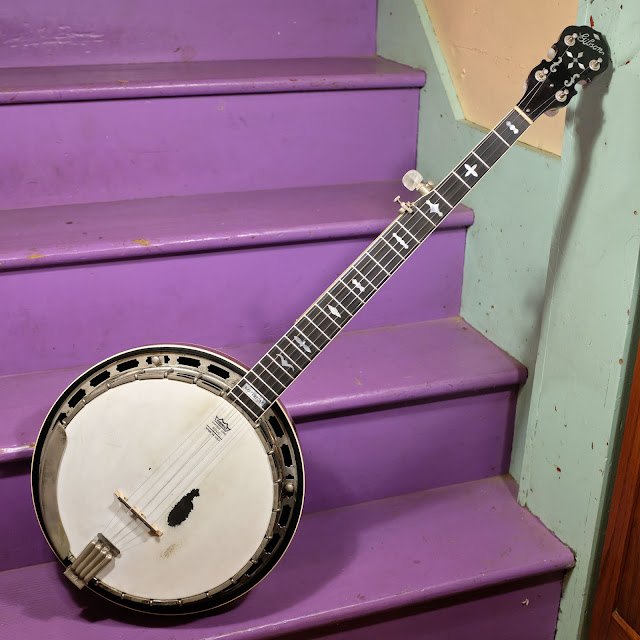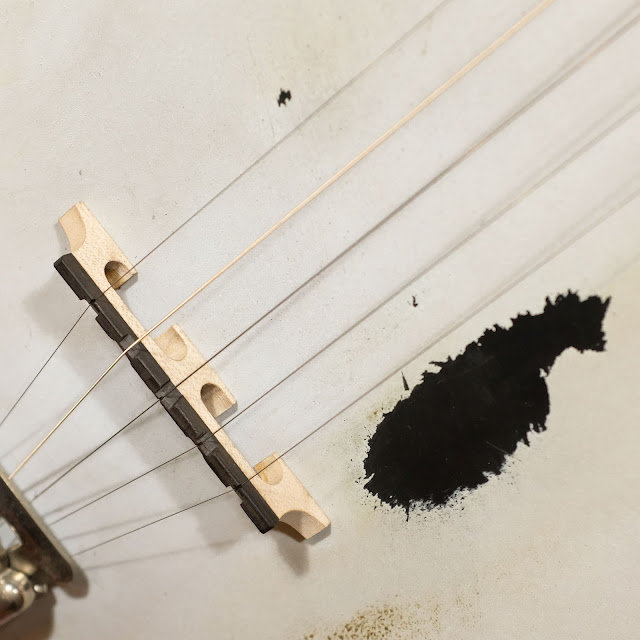1979 Gibson RB-250 Mastertone 5-String Resonator Banjo
Another Mastertone! This one was built in Kalamazoo just prior to Gibson's move down to Nashville. It has the goods and delivers a punchy but sweet bluegrass tone. There's nothing like a Gibson if you want that vibe. It must be something in the water over there -- because a flathead ring on a Mastertone banjo just sounds that way.
This has a fast-as-all-get-out neck, too, and has been a one-owner instrument. The plating on all the hardware has tarnished a medium amount and so it looks older than it is, but personally I love that look. In the case of this instrument, it means that it's been played-in. The owner bought it new when he was in high school.
Overall, the instrument is in good health and I only had to do a minor amount of work to get it playing perfectly. As a bonus, it has a sliding 5th-string capo installed already. The 5th pip is a little high for perfect tonality using the capo, but I can adjust it so the string rides over the 5th fret if the next owner desires.
Work included: a fret level/dress, new compensated 5/8" bridge, general cleaning, and a good setup. The neck is straight, the truss rod works perfectly, and action is spot-on at 1/16" overall at the 12th fret. I have it strung with light gauges in 9, 22w, 14, 11, 9.
Scale length: 26 3/8"
Nut width: 1 3/16"
String spacing at nut: 31/32"
String spacing at bridge: 1 11/16"
Head diameter: 11"
Resonator diameter: 13 3/4"
Side depth: ~4"
Neck profile: flat board, quite slim C-shape rear
Weight: 11 lb, 0 oz
Rim wood: ply maple
Resonator wood: ply mahogany
Neck wood: mahogany
Fretboard: rosewood
Condition notes: the banjo is 100% original save added 5th string capo. There's tarnish/wear to the parts but the finish and overall instrument is quite clean. Frets are leveled and dressed but there's plenty of life in them. The tuners are still going strong, too!
It comes with: its original hard case.
It comes with: its original hard case.
The tailpiece accepts ball or loop-end strings, which is nice.

















Comments
https://drive.google.com/file/d/1z0t_XPeeqeV4vP4dmRwBEPbX0oUtkVDl/view?usp=drivesdk
The reality is that there's actually a heap of difference between them. The Gibson necks are always higher quality and that goes for the overall construction, reliability, hardware, and tonering, too.
I have a lot of experience with nicer-grade Japanese 5-strings, though, and there are definitely some '70s models that clearly keep pace with US-made Mastertones. My favorites have always been the higher-quality Iida banjos which were basically Mastertone copies down to the number of plys used on the rim...!